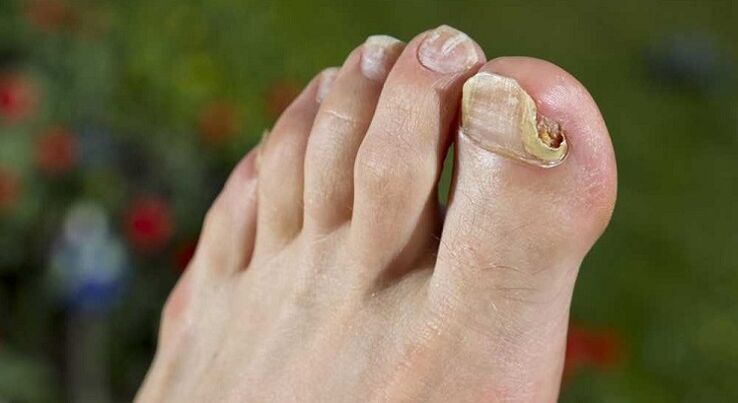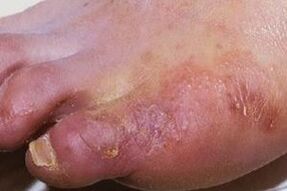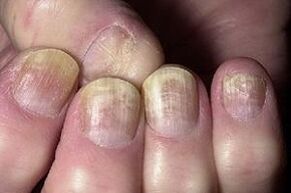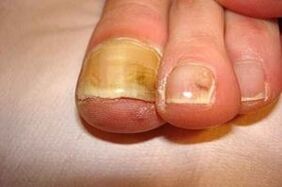Not everyone knows what nail fungus looks like, and they can first diagnose and treat the disease. Itching, redness, peeling and cracking are symptoms of this condition. However, there are other diseases such as eczema or psoriasis with similar symptoms. Toenails can also change their appearance not due to a fungal infection, but due to psychological stress or a number of diseases of the internal organs. Thus, the final diagnosis can be made only after receiving the test results by a doctor. The patient's task is to see a doctor in time if warning signs appear.

The main symptoms of mycoses
The characteristic symptoms of mycosis of the feet are peeling and, in most cases, a certain form in the form of rings or plaques. Sometimes it is so insignificant that such a situation can last for months, if not years, and at the same time does not cause much concern. At the same time, some people try to deal with such manifestations of mycosis on their own. They use folk remedies such as iodine, vinegar and bright green, and for a while the disease really disappears. Rather, it seems so, but in reality, this treatment causes the fungus in the legs to simply freeze and continue to multiply when a more favorable situation arises.
Moreover, if such a disease is not completely cured at an early stage, if only the symptoms are eliminated, it will soon spread to the nails and smooth skin. Needless to say, other family members can get fungal infections.

The degree of lesion in the mycosis of the feet depends on many factors. If there are initial conditions such as microtrauma, various pathologies of the endocrine system, diabetes mellitus, if a person is receiving certain treatment with glucocorticoids or cytostatics, all this contributes to the further development of the disease.
One day the period of relative stability comes to an end and the patient does not see the most attractive scene - it's not just peeling on the skin, but also bubbles, cracks in the legs, pain. All these are classic symptoms that are present in the later stages of the pathology. At the same time, the initial stage of nail fungus is visible. Although the type of microorganisms can only be examined in more detail under a microscope, their activity is more noticeable - a change in the shape and color of the nails, followed by thickening and destruction.
Fungus and manifestations on the nails
The elasticity of the nails manifests itself in different ways. It all depends on the stage of the disease and what fungus is causing it. Normally the nail should be smooth, pink and even shiny. If the condition of the nails is far from the ideal described, something is happening in the body.
Nails grow at a certain speed. When a person is stressed, this ratio decreases and the nail becomes thin and weak. Then the body returns to normal and the nails return to their previous position from the point of growth indicators, but this weak streak on the nail plate still remains. If a person's life is very stressful, there may be several such streaks. In addition, onychomycosis (and this is the scientific name for nail fungus) is not the only disease that causes a change in the color or shape of the nail plate. Pathologies such as immune deficiencies, hormonal imbalances and other endocrine system disorders lead to exactly the same results. Therefore, it is necessary to conduct a separate analysis in each case.
The appearance of the fungus depends largely on the microorganisms that cause onychomycosis. And it can be triggered by several species. For example, if we talk about dermatophytes, the fungus looks like nail polish. This is a manifestation of the initial stage of nail fungus. After that, yellow spots may appear on the edge and even in the middle of the board. Then longitudinal stripes appear and the nail begins to sink.
Otherwise, problems arise caused by yeast. In such cases, the nail plate becomes noticeably thinner, acquires a gray color, and after a while returns to normal. This is mainly due to the deterioration of metabolism in injured cells. At the same time, the resulting grooves in the nail layer finally confirm the diagnosis - yeast.
The mold should be marked separately. It generally affects only the nail plate, becoming cloudy and discolored; can be light yellow, green, brown and even black.
The peculiarity of these fungi is that they only cause surface damage and do not penetrate deeply.
Only a doctor who will review all the symptoms and perform tests can be involved in the diagnosis. Treating yourself without going to a doctor is fraught with very unpleasant consequences.
Stages and types of onychomycosis

Given the stages of onychomycosis, many confuse them with three types of the disease. These are normotrophic, hypertrophic and atrophic onychomycosis.
For example, during normotrophic onychomycosis, the color of the nail may change, streaks and spots may appear on it, but the thickness and luster remain normal. Many people think that the initial stage of this is a nail fungus, which is about to turn into a more serious pathology, but in fact the fungus in this condition responds well to treatment.
With hypotrophic onychomycosis, the nail changes color, loses its luster, the nail itself thickens and deforms, and in some cases even disappears along the edges. Onycholytic species are often called atrophic. This is not the same nail fungus, the initial stage is characterized by cracks and discoloration, where the treatment will be different, because the affected part of the plate atrophies.
Treatment of mycosis of the feet and nails
The first thing to do with this disease is to consult a doctor who will help you choose a drug that meets the following requirements:
- high antifungal activity, which allows to fight various infectious agents;
- a sufficiently high concentration of the active substance both in the drug itself and in the surface layers of the skin after application;
- complex antifungal and antibacterial therapy;
- no contraindications and side effects, including allergic reactions;
- ease of use.
Given these requirements, it is not surprising that the drug selection phase is so important. As a rule, in the absence of complications, drugs based on substances such as cyclopirox and naftifin are used. They are produced in the form of ointments, less in the form of tablets. In more severe stages of mycosis, treatment with terbinafine and fluconazole-based drugs is recommended.
If there are no ointments or creams for external use, tablets should be taken. The dose of tablets should be checked by the attending physician. As a rule, all of these drugs are quite strong, so the course of treatment is about 7-10 days, although there are drugs that can be taken for 3-4 weeks.
The attending physician prescribes such therapy, taking into account what other medications the patient will take. These medications can cause side effects such as vomiting or dizziness. This is considered valid. Common medications are milder than original medications, but have less effect.
Operational interventions
In previously developed cases, surgical removal of the affected tissue was used. This was especially true of nails. Now they use a drill as used in dental offices. Even in the most advanced cases, it will take about half an hour to cut almost all the nails. If the problem is only in an affected nail, it will only take 5 minutes.

There is no need to take additional measures after the procedure. This procedure does not cause painful feelings, you can lead a normal lifestyle, you can run in the morning. It is important to ensure that the affected areas of the skin are not damaged.
One treatment of the nails with such a preparation is not enough, but 3-4 weeks after the first treatment, it should be repeated at least once when the nails grow a little. In general, this period is long, it can take a month, and if everything is long enough, it should take a few months. For example, in the first 3-4 months, a patient is treated with such a tool every 2-3 weeks, and then takes the drug for several months.
Are folk remedies effective?
Any doctor will say that traditional medicine prescriptions for such a disease are ineffective and even harmful. First, despite the antiseptic substances, neither vinegar, nor herbs, nor honey, do not affect the fungus. Yes, you may hear from your friends that some of these recipes help to get rid of itching or cracks. Well, these symptoms were not just fungi. The same psoriasis or eczema has similar symptoms and is perfectly treated with the above folk methods.
Second, these drugs help to eliminate the symptoms of the fungus, that is, they mask for a while, and this is enough to infect everyone in the family.
However, the vinegar mentioned above will be effective for other purposes - it can be used to wash bedding and shoes to prevent the fungus from spreading again. The only shoes that are not washed and discarded are slippers because they cannot be disinfected. Vinegar can also be used to disinfect the bath.





























